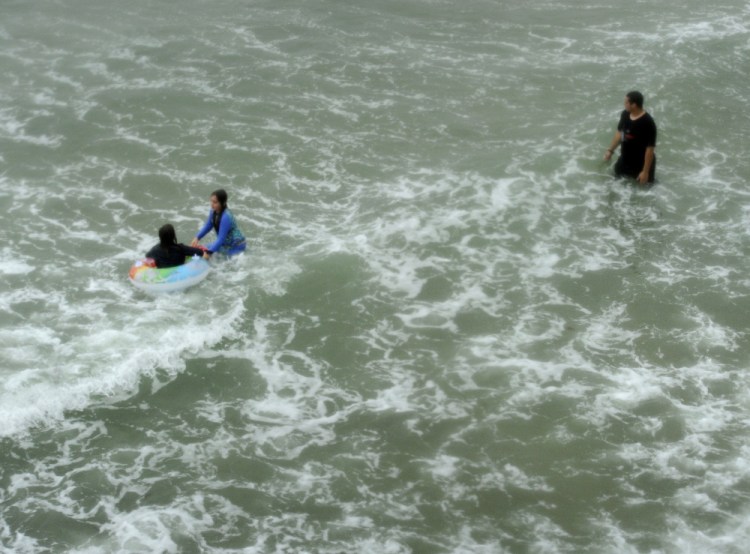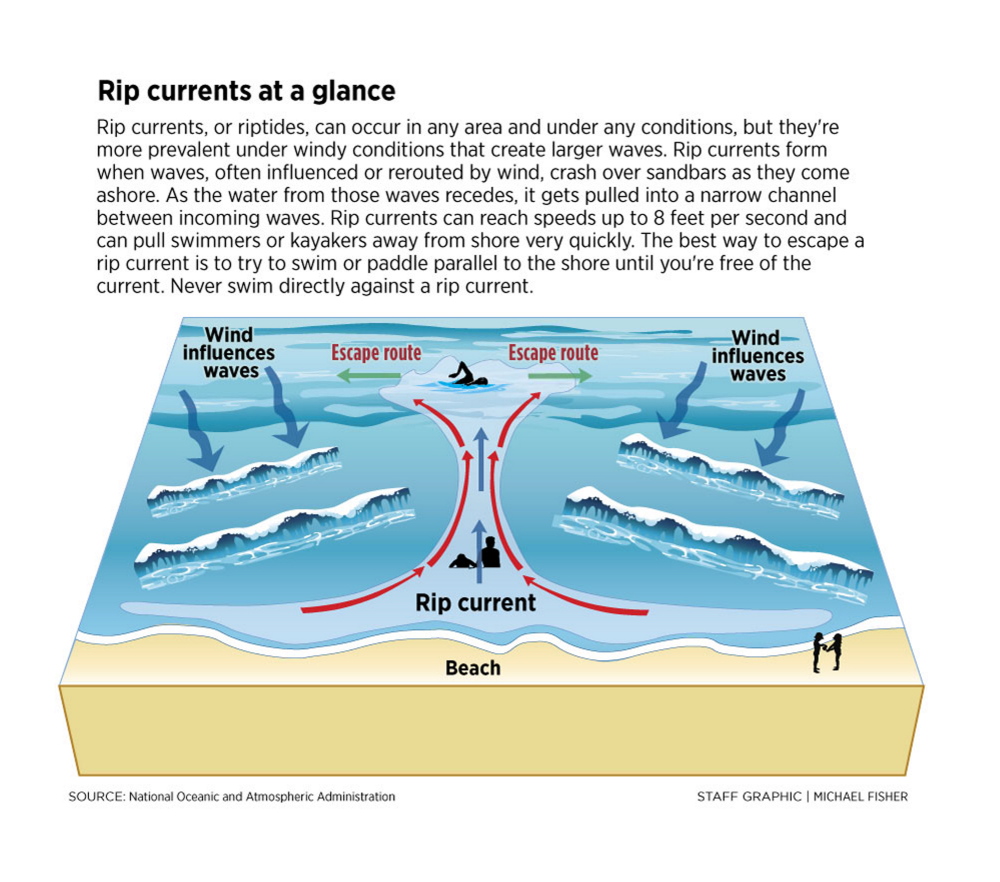Strong tidal currents that have created dangerous swimming and boating conditions along Maine’s southern shoreline are expected to ebb as the week continues, but beachgoers are being advised to remain cautious in the wake of two fatalities.
“It’s really not all that uncommon this time of year,” Chris Legro, a meteorologist with the National Weather Service office in Gray, said of the rip currents. “We often find that the days that end up seeing the most rescues, the waves are a bit smaller, so people let down their guard.”
Monday was an especially busy day for lifeguards along the coast.
In Old Orchard Beach, they rescued 10 people who got caught up by strong rip currents along the popular, tourist-heavy beach.
A little farther south, in Hampton Beach, New Hampshire, lifeguards assisted 18 people Monday, according to The Associated Press.
Rip currents also were a problem at beaches on Cape Cod and as far south as Rehoboth Beach, Delaware, and Virginia Beach, Virginia.
The rescues Monday in Maine came after a Scarborough man drowned off Pine Point Beach on Saturday. A Westbrook man who was rescued from Hills Beach in Biddeford on Saturday died Tuesday.
Legro said the weather conditions Monday – moderate onshore wind from a storm system coupled with medium-size waves – were ideal for rip currents.
“One of the things that factors in is the distance between waves,” he said. “When a wave crashes into shore and then recedes, it will pick up more speed and be more likely to create a riptide if there isn’t another wave immediately coming in.”
FASTER THAN A HUMAN CAN SWIM
Rip currents often occur when waves break over sandbars toward a beach and then recede, pulling water away in narrow channels at speeds of up to 8 feet per second – faster than a human can swim. Sand bars, piers and jetties can sometimes contribute to rip currents. Swimmers or kayakers who get caught in the current can be pulled a significant distance in a short time.
The best thing to do when caught in a current is to swim or paddle parallel to the shore, not against the current, to get out of the current, even though that goes against people’s natural instincts to head for shore.
“It always helps to be patient and calm and try to get outside the current,” said U.S. Coast Guard Lt. Scott McCann.
Many popular beaches use a flag system to let visitors know what water conditions are each day. Green flags indicate conditions are safe, yellow flags tell people to use caution and red flags warn swimmers to stay out of the water.
The system isn’t foolproof, though. On Monday, for instance, flags on busy Old Orchard Beach were green.
“People can always check with the lifeguards on duty,” said Fire Chief Ricky Plummer. “They know the water and the conditions of that day. That’s what they are there for.”
MORE MAINE RESCUES THAN USUAL
Plummer said the lifeguard captain on duty each day will assess the conditions and swim in the water to get a sense of what currents are like.
Some spots, including an area near Ocean Park and the water under the well-traveled pier, have historically been problematic for rip currents.
The department recently purchased a personal watercraft that will make water rescues easier, Plummer said. He expects it to be in the water this week.
In Ogunquit, another popular summer beach spot in southern Maine, lifeguards do similar assessments each day about water conditions.
Fire Chief Mark O’Brien said the main beach in Ogunquit is connected to a tidal river. When the tide goes out in that channel, he said, boaters and kayakers often can get caught.
“This season has been a little busier for us than usual in terms of rescues,” he said. “But we’ve had a lot more traffic on the beach, too.”
Although swimmers are at the highest risk, McCann said kayakers and occupants of small boats should use caution, too. They should wear life jackets and tell someone on shore where they are going.
“We have a lot of people that are coming here from other areas and might not realize how high the tides can get,” he said. “In a kayak or small boat, 4- to 7-(foot) seas, that’s significant.”
Tuesday’s rainstorm meant most beaches were unoccupied, and Legro said water conditions were expected to calm as the week progresses.
Although the rescues in Old Orchard Beach and farther down the coast on Monday did not involve fatalities, the risk is always present. Dozens of people die every year from getting caught in rip currents.
Scott Ducott, 56, of Scarborough died after being pulled from the water off Pine Point Beach on Saturday.
Another man, Jason Brawn, 46, of Westbrook, died at Maine Medical Center in Portland on Tuesday after being rescued from Hills Beach in Biddeford on Saturday.
Send questions/comments to the editors.





Success. Please wait for the page to reload. If the page does not reload within 5 seconds, please refresh the page.
Enter your email and password to access comments.
Hi, to comment on stories you must . This profile is in addition to your subscription and website login.
Already have a commenting profile? .
Invalid username/password.
Please check your email to confirm and complete your registration.
Only subscribers are eligible to post comments. Please subscribe or login first for digital access. Here’s why.
Use the form below to reset your password. When you've submitted your account email, we will send an email with a reset code.